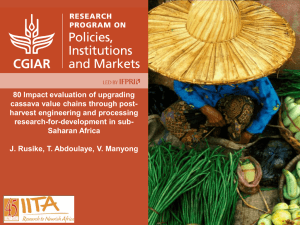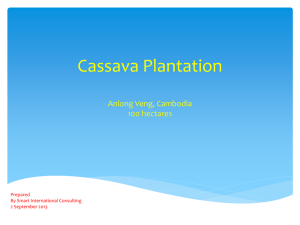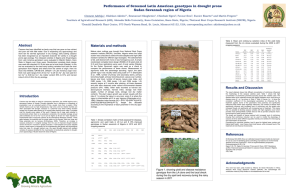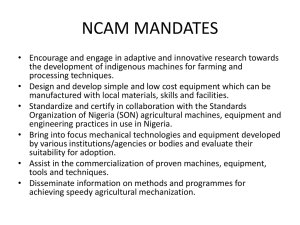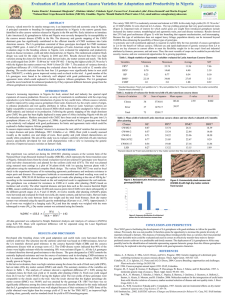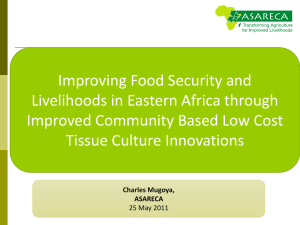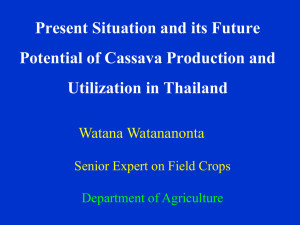powerpoint slides
advertisement
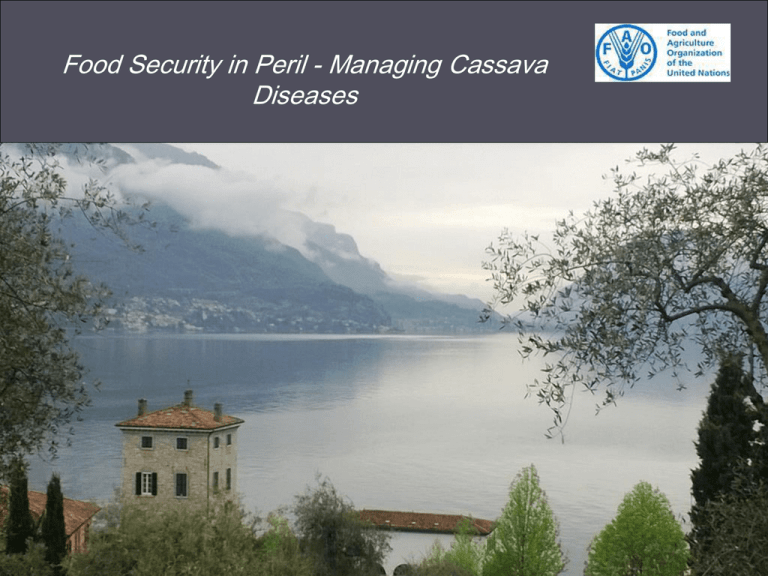
Food Security in Peril - Managing Cassava Diseases Author Cassava R&D specialists, investors and partner institutions met in Bellagio, Italy to address the growing threat to cassava in Africa from two deadly virus diseases: Cassava Mosaic Virus (CMV) and Cassava Brown streak Virus (CBSD) • • • • • • Virologists Entomologists Breeders Seed system specialists Socio-economists International development partners CMD • Cassava mosaic disease (CMD) is present in all cassava growing African countries. • CMD is caused by at least 8 different viruses, transmitted by white flies and cuttings from infected plants. • At least 45 million metric tons of cassava are lost each year to CMD. • A new recombinant virus exploded in Uganda in the 90s and completely suppressed cassava production in the region. Spread of the Cassava Mosaic Disease 2013 2005 2001 1997 – EACMVUG CBSD • Cassava brown streak disease (CBSD) was first described in 1935 and reappeared in East Africa in 2003, causing a severe epidemic. • CBSD is now the worst constraint for cassava in East Africa. • CBSD is caused by two viruses transmitted by white flies and cuttings. • CBSD is dramatic because it does not impact the growth of the infected plants but completely compromises the harvest, as all the roots are necrotic. Spread of Cassava Brown Streak Disease 2004 2013? 2005 2009 GCP21 GCP-21 is a recognized global organization within the cassava community. GCP-21 aims to draw a comprehensive plan to halt CMD and CBSD and prevent CBSD from reaching West Africa, the largest cassava region in Africa. Two questions: 1) Can we curtail spread of CMD and CBSD? 2) How should we curtail their spread? Considerations: 1) What is known about the diseases? 2) Do we have quality planting materials? 3) How much materials can be made available? 4) Is the institutional environment conducive? 5) Can we ensure quality for impact? Priority 1: Contain the CMD/ CBSD spread in East Africa and prevent its spread to West Africa • Raise awareness of the risks of inter country germ plasm movement amongst technicians and policy makers; • Mount a surveillance program to define the distribution of cassava cultivation, and varieties and abundance/incidence of cassava white flies and viruses; • Employ targeted best bet virus and whitefly management strategies in new outbreaks; • Educate high level policy makers to support these initiatives and establish and link national task forces on cassava virus and white fly control Priority 2: Eliminate or decrease the impact of CBSD and CMD • Develop/select farmers’ preferred virus and white fly resistant/tolerant varieties; • Promote community based phytosanitation; • Prioritize target zones for intervention based on existing data and new surveillance information; • Develop and implement whitefly management using biological control, rational use for high value systems (clean seed sites) and IPM strategies. Priority 3: Prevent the spread of white fly and viruses globally • Strengthen controls on inter-continental germ plasm interventions; • Update the guidelines for safe movement of cassava; • Raise awareness of the risks on intercontinental germ plasm movements amongst technicians and policy makers; • Strengthen globally capacities on cassava value chain-related issues. Implications for SS 1 Seed systems development • Introduce new varieties • Develop clean planting material • Replace seed that has been lost Quality control issues • Surveillance, inspection and phyto-sanitation • Capacity/awareness raising issues – community level • Field school approaches; community based phyto-sanitation; Negative/positive selection • Quality control through agri-business models? Delivery channels – foundation seed • • • • • Willingness to pay principle Formal (officially registered) Informal (community based seed producers) Commercial (Mr. Big but producing for whom) Campaign based distributors (NGOs – code of conduct, registration of NGOs) Seed production/distribution • Production and protection of basic seeds /breeder seeds; • Specialized seed producers – getting the markets right; • Speed as a criterion (Tissue culture); • Seed health as a criterion: indexing of tissue culture materials; • Developing economies of scale (reduced costs from USD 1/TC to 0.5USDCents) • Hardening – reduce losses – how do we bulk more effectively? THANK YOU
